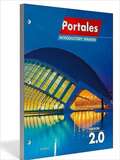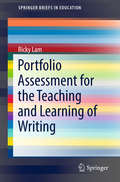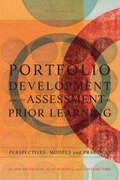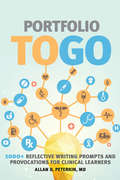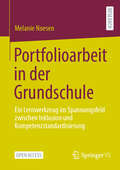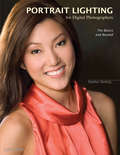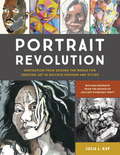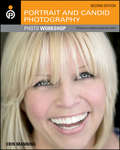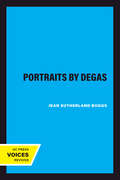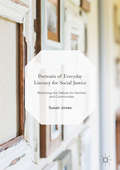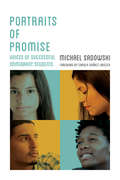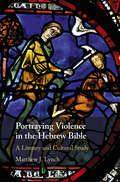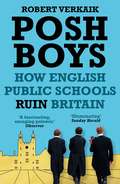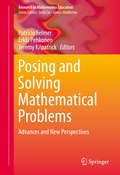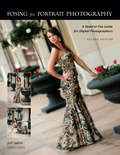- Table View
- List View
Portals and Libraries
by Sarah C. MichalakCutting-edge information about providing access to research library usersThe ultimate goal of librarians is to provide comprehensive informational access to library users. Portals and Libraries provides an in-depth look at various libraries&’ challenges and the cutting-edge technology used in providing high-quality electronic access to users through portal systems. Respected authorities detail efforts to build a new kind of search and retrieval system that includes access to the Web as well as other vital collections and academic resources. The book discusses the implementation of access systems and their supporting technology, and spotlights strategies designed to encourage quality system-user feedback, increase the cooperation and diligence of staff, and more. Portals and Libraries comprehensively reviews library portals from their roots to their current state, with a look at assorted products, their implementation issues, and each one&’s advantages and shortcomings. The overall state of the portal system today as well as where it is heading in the future is examined in detail. The book also provides the ARL Scholars Portal Working Group Final Report from May 2002 summarizing the group&’s work from its inception, and includes their recommendations of key portal features and needed functions. The text includes helpful screenshots, useful descriptive figures, and extensive references.Portals and Libraries discusses: the history of library portals the MyLibrary@NCState Web portal after five years of use "Portals to the World" Library of Congress guide to Web resources the role integrated library systems will play in the future of portals features and services to be added to library portals for greater success portal technologies-their structures and functioning planning portal implementation online catalogs usability testing and interface design nine key issues that will impact the future of portal developmentPortals and Libraries is crucial reading for library educators and students, college and research librarians in reference, library system professionals, and technical services professionals focused on applying cutting-edge technology to library services.
Portfolio Assessment for the Teaching and Learning of Writing (SpringerBriefs in Education)
by Ricky LamThis book provides teachers, instructors, scholars, and administrators with a practical guide to implement portfolio assessment of writing in their work contexts. Unlike most existing volumes, which underscore theory building, it describes and discusses several key issues concerning how portfolio assessment can be carried out in authentic classrooms with a focus on its processes, reflective components, task types and design, scoring methods and actionable recommendations.
Portfolio Development and the Assessment of Prior Learning: Perspectives, Models and Practices
by Alan Mandell Elana MichelsonFor over thirty years, portfolios have been used to help adult learners gain recognition for their prior learning and take greater control of their educational experiences. The portfolio has become a distinctive means of assessing such learning, serving as a meaningful alternative to conventional papers and standardized testing. Portfolio Development and the Assessment of Prior Learning: Perspectives, Models, and Practices provides a primer of flexible approaches to shaping and conducting portfolio-development courses. It offers practitioners in the field an extensive range of model assignments, readings, and classroom activities, each organized around a specific theme: Academic Orientation, The Meaning of Education, Personal Exploration, Learning from the Outsider Within, The World of Work and Careers, and Dimensions of Expertise. Twelve case studies by practitioners in the field then show how academics in the US and around the English-speaking world have adapted the portfolio to changing circumstances in order to deliver academically rich educational services for adults. These case studies highlight portfolio development in the context of web-based instruction, changing institutional imperatives, service to historically disenfranchised groups, partnerships with industry, and cross-institutional cooperation.In addition to serving as a valuable hands-on resource for practitioners, Portfolio Development and the Assessment of Prior Learning locates portfolios and assessment in a broad social and intellectual context. Thus, the authors also offer an historical overview of the usefulness of portfolios in the assessment of prior learning and then consider their use in the future, given current trends in higher education for adults. The book explores the implications of a changing educational landscape, in which new student populations, budgetary pressures, and understandings of knowledge both enrich and challenge student-centered approaches such as portfolios.The approaches and case studies are not only valuable to adult educators but, equally, to faculty in higher education concerned with the development of competency- and outcomes-based assessment.
Portfolio to Go: 1000+ Reflective Writing Prompts and Provocations for Clinical Learners
by Allan D. PeterkinPreparing a learning portfolio has become a mandatory part of the course work in most clinical professions. Students and educators alike sometimes complain that these mandatory assignments become repetitive and uninspired. However, we all need to be able to speak and write clearly as we work with our colleagues, students and those we care for. In Portfolio To Go, Allan D. Peterkin insists that reflective capacity, critical thinking, creative expression, and narrative competence are attributes that should be developed in every health professional - regardless of the discipline or specialty. Trainees will find over 1000 prompts organized under themes highly relevant to students and educators, including those not formally addressed in class, such as coping with uncertainty and ambiguity, team conflict, and resilience through good self-care. Practical tips for writing effectively and for discussing and evaluating narratives in a helpful, respective manner are provided throughout. Peterkin is a pioneer in emphasizing patient-centred, humanistic care and Portfolio To Go will help to train and develop more reflective practitioners.
Portfolioarbeit in der Grundschule: Ein Lernwerkzeug im Spannungsfeld zwischen Inklusion und Kompetenzstandardisierung
by Melanie NoesenDieses Open-AccesBuch thematisiert Portfolioarbeit in einer inklusionsorientierten Grundschule im Rahmen der luxemburgischen Bildungsreform und unter besonderer Berücksichtigung der komplexen Mehrsprachigkeitssituation des Großherzogtums. Das Portfolio wurde als wichtiges Instrument zur Implementierung eines Kompetenzmodells und einer neuen Leistungsbeurteilung angedacht und sollte nicht nur dem Lernen der Kinder, sondern auch der Unterrichtsentwicklung dienen. So geht die Studie der Frage nach, wie sich Lernen im Rahmen der Portfolioarbeit bei Kindern zu Beginn des Schriftspracherwerbs in einer inklusionsorientierten Grundschule gestaltet. Spezifischer fragt sie nach der Nutzung sowie der Deutung des Portfolios seitens der Kinder, der Lehrpersonen sowie der Eltern. Die Arbeit entwickelt und belegt die These, dass die Portfolioarbeit im Kontext der luxemburgischen Schulreform in der Praxis dem Antagonismus zwischen Inklusion und Kompetenzstandardisierung ausgesetzt ist. Weiter beleuchtet sie die Auswirkungen dieses systeminhärenten Widerspruchs auf den unterschiedlichen Ebenen. So beschreibt und analysiert sie die Umsetzung der Portfolioarbeit auf der Ebene des Lernens des Kindes, der Unterrichtsgestaltung, der Schule sowie der Bildungspolitik.
Portrait Lighting for Digital Photographers
by Stephen DantzigThe fundamentals of exposure and the essentials of lighting are explored in this photography reference that uses progressive images from portrait sessions as its basis of explanation. Starting with how light is perceived differently by the camera than the human eye, this resource clarifies the more complicated laws that govern light, breaking the rules down with clear, effective examples. Various light sources are investigated#151;from simple sunlight to advanced professional and studio systems#151;as well as the types of lighting units used at different times during the sessions. By adding or modifying one light at a time, a sequence of images shows how the desired effect was achieved, offering photographers step-by-step troubleshooting tips. Concise text paired with photo examples offer any portrait photographer the techniques needed to create perfectly lit images.
Portrait Mastery in Black & White
by Tim KellyTim Kelly is a Master Photographer whose portrait work has inspired people in the portrait photography industry since the 1980s. His work has a classic, polished quality that beautifully depicts the personality of each subject, with no gimmicks. His style is reliant on careful camera technique, flawless lighting, and an uncanny ability to coax the most flattering-possible pose from every man, woman, and child who steps in front of his camera.In this book, Tim Kelly presents 60 of his most impressive and diverse black & white portrait images of men, women, children, and groups. For each of the sixty images, readers will get a deconstructive look at every aspect of building the image, from the ground up. Kelly will discuss the creative concept behind his images and share the gear, exposure, lighting, and posing strategies he learned to create gorgeous black & white portraiture with an exquisite tonal range, beautiful, form-flattering highlights and shadows, and both refined and comfortable poses that invite the viewer to study the image frame.This book contains all of the information you need to create standout black & white portraiture-from conceptualization, to posing and lighting, to postproduction and printing options.
Portrait Painting Atelier: Old Master Techniques and Contemporary Applications
by Domenic Cretara Suzanne BrookerThe art of portraiture approached its apex during the sixteenth century in Europe with the discovery of oil painting when the old masters developed and refined techniques that remain unsurpassed to this day. The ascendance of nonrepresentational art in the middle of the twentieth century displaced these venerable skills, especially in academic art circles. Fortunately for aspiring artists today who wish to learn the methods that allowed the Old Masters to achieve the luminous color and subtle tonalities so characteristic of their work, this knowledge has been preserved in hundreds of small traditional painting ateliers that persevered in the old ways in this country and throughout the world.Coming out of this dedicated movement, Portrait Painting Atelier is an essential resource for an art community still recovering from a time when solid instruction in art technique was unavailable in our schools. Of particular value here is a demonstration of the Old Masters' technique of layering paint over a toned-ground surface, a process that builds from the transparent dark areas to the more densely painted lights. This method unifies the entire painting, creating a beautiful glow that illuminates skin tones and softly blends all the color tones. Readers will also find valuable instruction in paint mediums from classic oil-based to alkyd-based, the interactive principles of composition and photograph-based composition, and the anatomy of the human face and the key relationships among its features. Richly illustrated with the work of preeminent masters such as Millet, Géricault, and van Gogh, as well as some of today's leading portrait artists--and featuring seven detailed step-by-step portrait demonstrations--Portrait Painting Atelier is the first book in many years to so comprehensively cover the concepts and techniques of traditional portraiture.From the Hardcover edition.
Portrait Pro
by Jeff SmithDroves of hobbyist photographers make a move to professional photography every year. They read a few books, watch rock star photographers shoot online, make business cards, and forge their path to a new career. When they book clients, work through the session, proof their images, and conduct a sales session, though, they encounter artistic, organizational, and financial problems they had not anticipated, and many stall out.In this book, Jeff Smith focuses on finding an audience and a target demographic, honing your posing and lighting skills, working with clients, and managing business and personnel concerns.Smith begins by taking a close look at the mind-set required for forging ahead as a professional photographer. He shows you how to define and target the clientele you want to work with and teaches you skillful approaches for creating and maintaining a strong photographer-client relationship. He notes that many photographers enter the business to create images that please them and explains that to be successful, photographers must instead learn to gain insight into just what the client wants to see in the final photos in order to maximize profits and keep clients coming back for more.With a clearly defined objective and approach outlines, Smith moves on to tackle common technical issues that new pros find daunting. He provides tips for creating perfect lighting in the studio and outdoors. He also discusses positioning for every part of the body, to create an ideal presentation to the camera. Next, he provides compositional tips-from where to position the subject in the frame, to selecting the best camera angle, to cropping for impact-in order to maximize image impact and present the best-possible image to your client.Finally, with the technical and artistic fields addressed, Smith turns to a discussion on the business side of the profession. He offers advice on acquiring equipment, understanding costs and pricing, creating new business opportunities, identifying an ideal studio location, and even managing your time.
Portrait Revolution: Inspiration from Around the World For Creating Art in Multiple Mediums and Styles
by Julia L. KayBased on the popular international collaborative art project, Julia Kay's Portrait Party, this book features hundreds of portraits in multiple mediums and styles teamed with tips and insights on the artistic process. The human face is one of the most important subjects for artists, no matter their chosen medium. Pulling from 50,000 works of portraiture created by the artists of the international online collaborative project Julia Kay’s Portrait Party, Portrait Revolution presents a new look at this topic—one that doesn’t limit itself to one medium, one style, one technique, or one artist. By presenting portraits in pencil, pen, charcoal, oils, watercolors, acrylics, pastels, mixed media, digital media, collage, and more, Julia Kay and co. demonstrate the limitless possibilities available to aspiring artists or even to professional artists who are looking to expand creatively.Along with works in almost every conceivable medium, Portrait Revolution shines a spotlight on different portrait-making techniques and styles (featuring everything from realism to abstraction). With tips, insights, and recommendations from accomplished portrait artists from around the globe, this all-in-one inspiration resource provides everything you’ll need to kick-start your own portrait-making adventure.
Portrait and Candid Photography Photo Workshop
by Erin ManningThe secret to taking great "people pictures" is to observe your subjects, connect with them, and use your camera to its best advantage. Here's how to work with lighting, location, angle, composition, physical characteristics, environment, and countless other variables, including the unique challenges of photographing babies, group activities, and action. Learn to capture facial expressions, tell a story with a series of candids, add interest to large-group shots, and more. Apply these techniques and watch your subjects come to life.
Portrait of a Moral Agent Teacher: Teaching Morally and Teaching Morality (Routledge Research in Teacher Education)
by Gillian R. RosenbergTeaching morally and teaching morality are understood as mutually dependent processes necessary for providing moral education, or the communication of messages and lessons on what is right, good and virtuous in a student’s character. This comprehensive and contextualized volume offers anecdotes and experiences on how an elementary schoolteacher envisions, enacts, and reflects on the ethical teaching and learning of her students. By employing a personally developed form of moral education that is not defined by any particular philosophical or theoretical orientation, this volume relates that classroom-based moral education can, therefore, be conceived of and promoted as moral agency. Accentuated by the teacher’s voice to offer the experience of being in the classroom, this volume enables others to transfer relevant practices to their own teaching contexts.
Portraits by Degas
by Jean Sutherland BoggsThis title is part of UC Press's Voices Revived program, which commemorates University of California Press’s mission to seek out and cultivate the brightest minds and give them voice, reach, and impact. Drawing on a backlist dating to 1893, Voices Revived makes high-quality, peer-reviewed scholarship accessible once again using print-on-demand technology. This title was originally published in 1962.This title is part of UC Press's Voices Revived program, which commemorates University of California Press’s mission to seek out and cultivate the brightest minds and give them voice, reach, and impact. Drawing on a backlist dating to 1893, Voices Revived</DIV
Portraits of Everyday Literacy for Social Justice: Reframing The Debate For Families And Communities
by Susan JonesBased on an ethnographic study involving three families who live on a Midlands council housing estate, this book presents portraits of everyday lives - and the literacy practices that are part of them - as a way to explore the complex relationship between literacy and social justice. Each portrait focuses on a different aspect of literacy in everyday life: drawing on perspectives offered by the long and diverse tradition of literacy studies, each is followed by discussion of a different way of looking at literacy and what this means for social justice. The lens of literacy allows us to see the challenges faced by many families and communities as a result of social policy, and how a narrow view of literacy is often implicated within these challenges. It also illustrates the ways in which literacy practices are powerful resources in the creative and collaborative navigation of everyday lives.Arguing for the importance of looking carefully at everyday literacy in order to understand the intertwining factors that threaten justice, this book positions literary research and education as central to the struggle for wider social change. It will be of interest and value to researchers, educators and students of literacy for social justice.
Portraits of Literacy Across Families, Communities, and Schools: Intersections and Tensions
by Theresa Rogers Maureen Kendrick Suzanne Smythe Jim AndersonDesigned to stimulate debate and critical thinking and to draw readers' attention to the ideological nature of literacy education across a broad range of literacy contexts, this book crosses traditional boundaries between the study of family, community, and school literacies to offer a unique global perspective on multiple literacies, from theory to case studies of various settings. These examples suggest ways that literacy practices should be created by simultaneously shaping relationships and identity, and by privileging particular literacy practices in particular situations. The dialogue within the book among chapter authors writing across traditionally distinct fields highlights the interconnections among diverse literacy sites and stimulates the pursuit of a more integrated and interdisciplinary approach to literacy education. The critical and dialogic approach serves to challenge and extend many conventional notions surrounding literacy education in communities, schools, and families.Portraits of Literacy Across Families, Communities, and Schools: Intersections and Tensions is particularly relevant for scholars and students in the area of literacy, broadly speaking, including family literacy, community literacy, adult literacy, critical language studies, multiliteracies, youth literacy, English as a second language, language and social policy, and global literacy. Additionally, the inclusion of studies derived from a variety of research methods and designs makes this is a useful text in research methodology courses that aim to present and analyze real-life examples of literacy research designs and methods.
Portraits of Promise: Voices of Successful Immigrant Students
by Carola Suárez-Orozco Michael SadowskiBy 2040, more than 30 percent of students in the United States will be immigrants or the children of immigrants. What factors can help these young people thrive in school, despite the many obstacles they face? And how can school staff best support immigrant students' academic and personal success? In Portraits of Promise, educators hear from the ultimate experts--successful newcomer students. Drawing on the students' own stories, the book highlights the kinds of support and resources that help students engage positively with school culture, establish supportive peer networks, form strong bonds with teachers, manage competing expectations from home and school, and navigate the challenges of high-stakes testing and the college application process.
Portraits of Promise: Voices of Successful Immigrant Students (Youth Development and Education Series)
by Michael SadowskiBy 2040, more than 30 percent of students in the United States will be immigrants or the children of immigrants. What factors can help these young people thrive in school, despite the many obstacles they face? And how can school staff best support immigrant students&’ academic and personal success? In Portraits of Promise, educators hear from the ultimate experts—successful newcomer students. Drawing on the students&’ own stories, the book highlights the kinds of support and resources that help students engage positively with school culture, establish supportive peer networks, form strong bonds with teachers, manage competing expectations from home and school, and navigate the challenges of high-stakes testing and the college application process.
Portraying Violence in the Hebrew Bible: A Literary and Cultural Study
by Matthew J. LynchMost studies on violence in the Hebrew Bible focus on the question of how modern readers should approach the problem. But they fail to ask how the Hebrew Bible thinks about that problem in the first place. In this work, Matthew J. Lynch examines four key ways that writers of the Hebrew Bible conceptualize and critique acts of violence: violence as an ecological problem; violence as a moral problem; violence as a judicial problem; violence as a purity problem. These four 'grammars of violence' help us interpret crucial biblical texts where violence plays a lead role, like Genesis 4-9. Lynch's volume also offers readers ways to examine cultural continuity and the distinctiveness of biblical conceptions of violence.
Portuguese Sociology: A History (Sociology Transformed)
by Filipe Carreira da SilvaSociology in Portugal provides the first English-language account of the history of sociology in Portugal from 1945 to the present day. Banned by the fascist regime until 1974, the institutionalization of sociology as an academic discipline came relatively late. Understanding academic disciplines as institutionalized struggles over meaning, Filipe Carreira da Silva gives a genealogy of sociology in Portugal from its origins in the political-administrative interstices of a dictatorship, through the 'cyclopean moment' of the political revolution of April 1974, which brought about its swift institutionalization and subsequent consolidation in the new democratic regime, to the challenges posed by internationalization since the 1990s. Attempts to define Portugal itself, he demonstrates, have been at the heart of these struggles. Analyzing agents, institutions, contexts, instruments and ideas, Carreira da Silva shows in fascinating detail how the sociological understanding of Portugal evolved from that of a developing society in the 1960s, to that of a modernizing European social formation in the 1980s, to the post-colonial or post-imperial Portugal of today.
Portuguese as an Additional Language (SpringerBriefs in Linguistics)
by Ana C. NevesThis book focuses on Portuguese as an additional language and its young learners in threecase studies within the Portuguese-speaking world: Portuguese as a second language inCape Verde, Portuguese as a heritage language in Switzerland and Portuguese as a foreignlanguage in Macao SAR. The term “additional language” is used as an umbrella term for allthree contexts.An analysis of these three case studies is presented, with a focus on the organization of explicit and implicit language policies with regards to population mobility and also motivational issues, language attitudes and language use by the sample population.
Poruliyal Kotpaadu (Economic Theory) 12th Standard - Tamilnadu Board
by Training State Council of Educational ResearchPoruliyal Kotpaadu (Economic Theory) Textbook for the 12th Standard Students, preparing for Tamil Nadu State Board Exam.
Posh Boys: How English Public Schools Ruin Britain
by Robert Verkaik&‘The latest in the series of powerful books on the divisions in modern Britain, and will take its place on many bookshelves beside Reni Eddo-Lodge&’s Why I&’m No Longer Talking to White People About Race and Owen Jones&’s Chavs.&’ –Andrew Marr, Sunday Times &‘In his fascinating, enraging polemic, Verkaik touches on one of the strangest aspects of the elite schools and their product&’s domination of public life for two and a half centuries: the acquiescence of everyone else.&’ –Observer In Britain today, the government, judiciary and military are all led by an elite who attended private school. Under their watch, our society has become increasingly divided and the gap between rich and poor is now greater than ever before. Is this the country we want to live in? If we care about inequality, we have to talk about public schools. Robert Verkaik issues a searing indictment of the system originally intended to educate the most underprivileged Britons, and outlines how, through meaningful reform, we can finally make society fairer for all.
Posing and Solving Mathematical Problems
by Jeremy Kilpatrick Patricio Felmer Erkki PehkonenThis book collects recent research on posing and solving mathematical problems. Rather than treating these two crucial aspects of school mathematics as separate areas of study, the authors approach them as a unit where both areas are measured on equal grounds in relation to each other. The contributors are from a vast variety of countries and with a wide range of experience; it includes the work from many of the leading researchers in the area and an important number of young researchers. The book is divided in three parts, one directed to new research perspectives and the other two directed to teachers and students, respectively.
Posing for Portrait Photography: A Head-to-Toe Guide
by Jeff SmithPhotographers learn how to gauge the needs of their clients before placing them into a stale, preconceived #147;women’s,” #147;men’s,” or #147;children’s” pose that hardly fits the client’s personality or preferences. Provided with a two-pronged approach to fail-safe posing, photographers learn first to determine what the mood of the portrait should be and how to use an appropriate posing genre#151;traditional, casual, glamour, or journalistic. Photographers are then shown how that genre can be used as a basis to produce a pose that best suits the client, allowing them to create dynamic yet natural-looking pose that the subject#151;and the intended recipient#151;will love.
